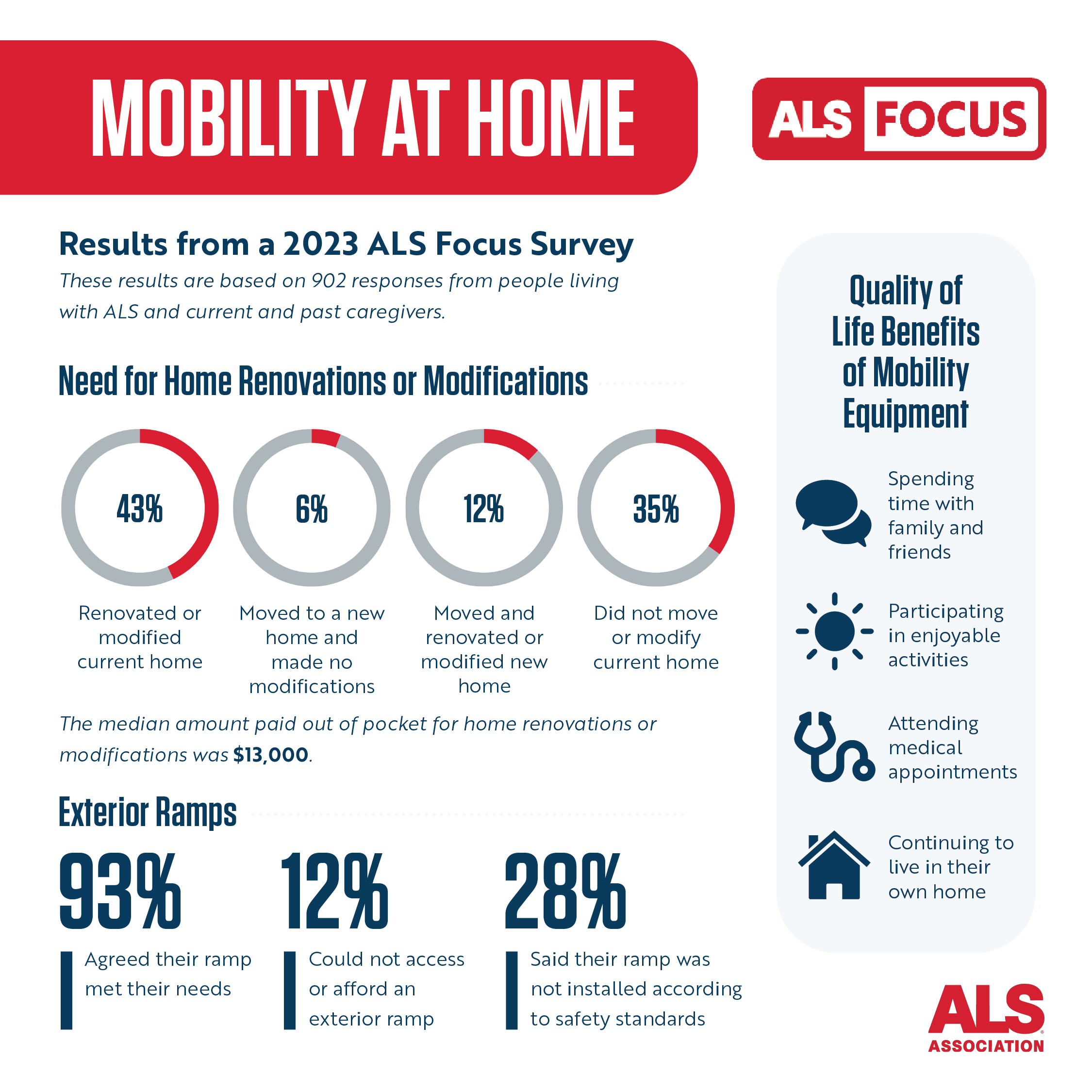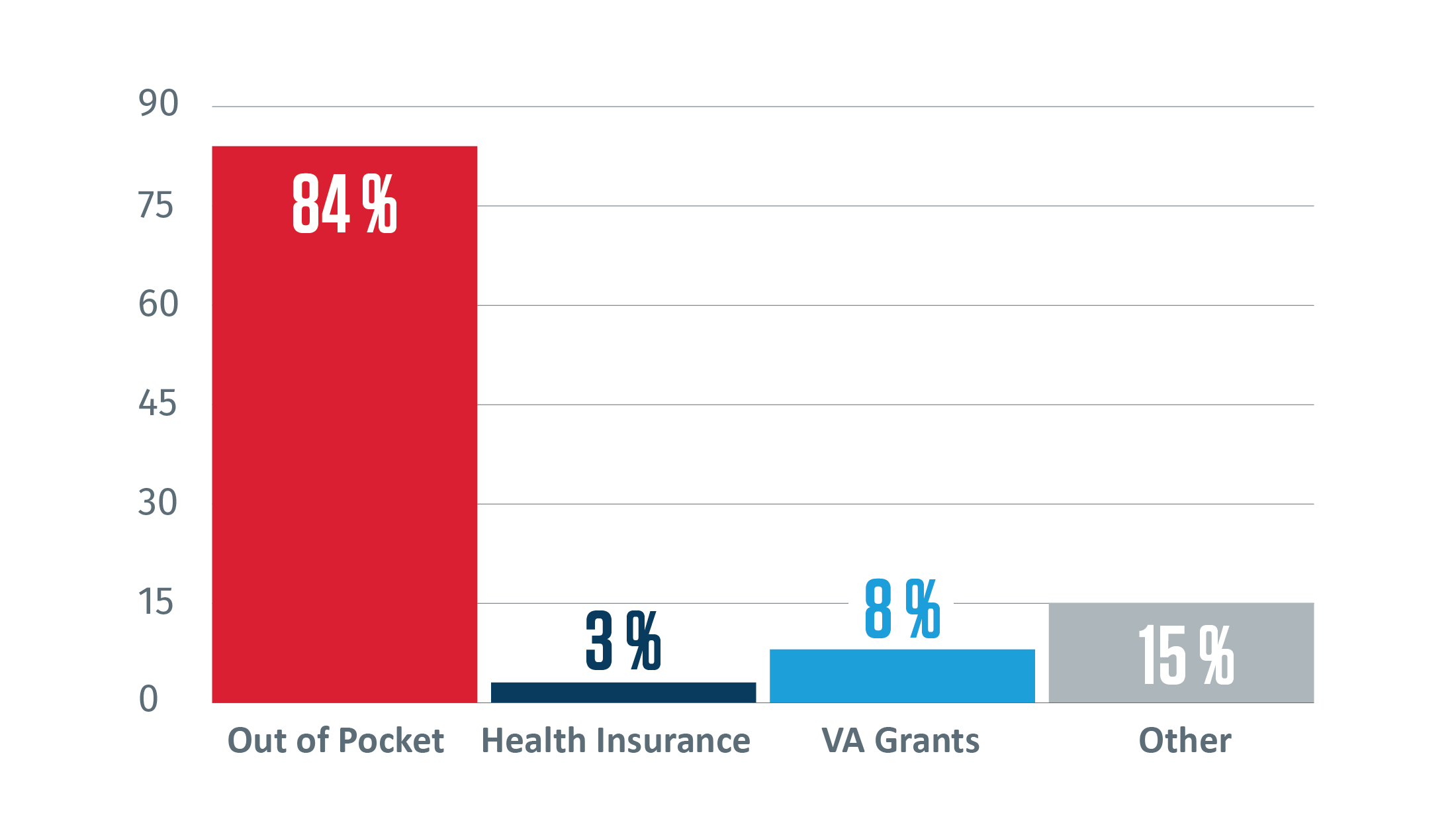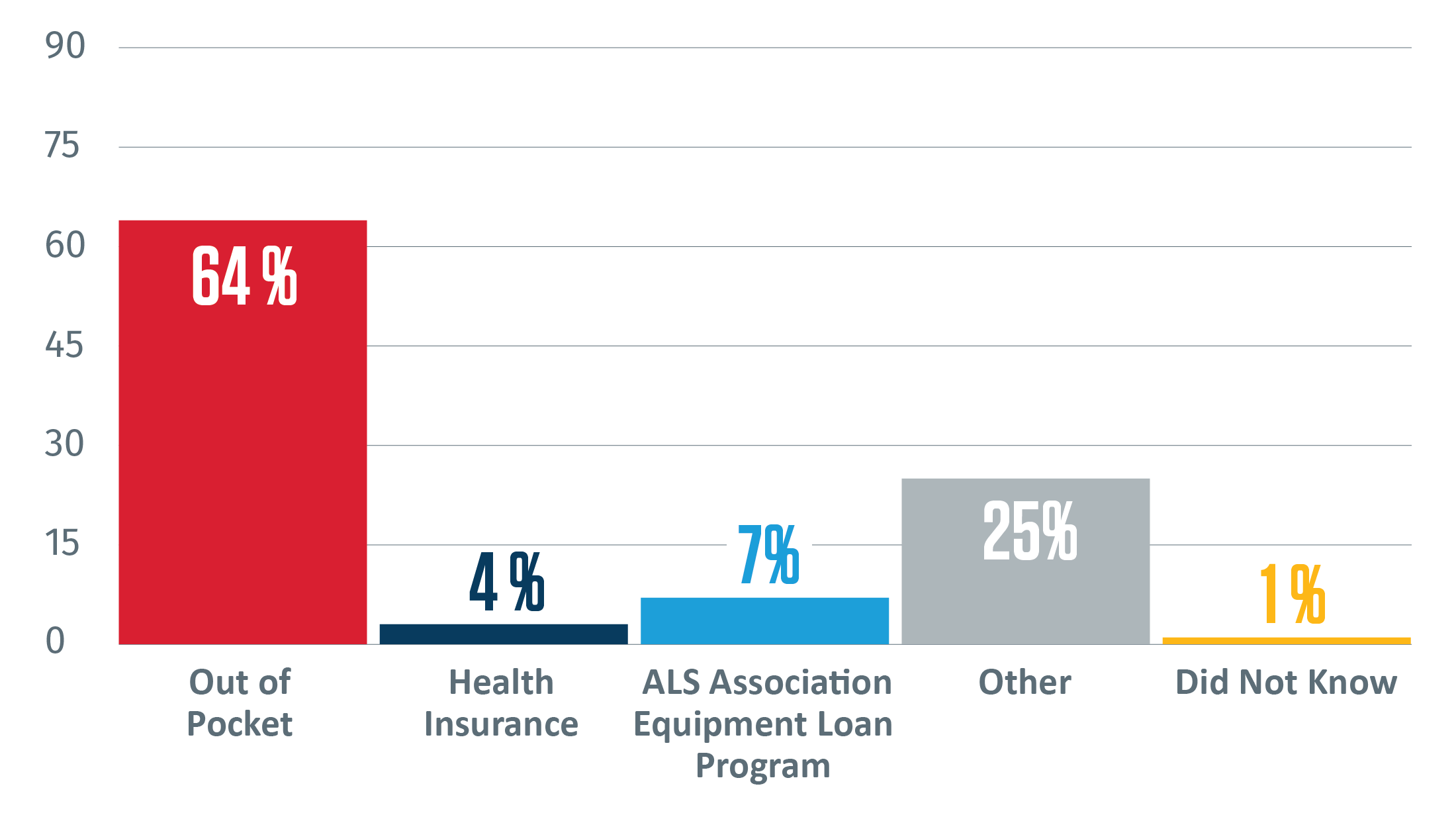Key Findings

Physical weakness and mobility issues are commonly associated with ALS, especially as the disease progresses, and greatly affect people’s lives and sense of wellbeing. The results of this survey show that mobility equipment can positively impact quality of life by aiding with participation in daily activities and interactions that increase access to care, which may help sustain feelings of social connectedness.
Even with mobility equipment, navigating the home can still be challenging for people living with ALS. More than half of participants (61%) reported they had to move and/or renovate/modify their homes to make it easier to live with ALS (n=547). Such modifications can be costly. The median (middle) amount paid out of pocket for home renovations or modifications was $13,000, with many participants reporting costs ranging from $4,000 to $30,000 (interquartile range, which is the middle 50% of dollar amounts participants reported spending). Of those who did not modify their homes (N=376), 18% said they could not afford to make needed changes.
Participants were also asked about their needs and experiences with fixed, permanent exterior ramps that provide wheelchair access into or out of a home. Almost half (43%) of participants (n=390) reported they currently use an exterior ramp or have used one in the past. Nearly all (93%) of those who used an exterior ramp agreed it met their mobility needs at home (n=364), suggesting that exterior ramps are highly useful for those who can access them.
Unfortunately, 12% of survey participants (n=108) said they could not afford or access an exterior ramp. While there are programs sponsored by the Veterans Administration (VA), ALS Association, Compassionate Care ALS (CCALS), and others, only a quarter of those surveyed (25%) reported using one of these programs to acquire a ramp. Ramp installation and safety were also a concern for some participants. More than one in four (28%) said their ramp was not installed by qualified professionals according to safety standards. An additional 12% weren’t sure if safety standards were followed during installation.
Being able to get into, out of, and around their homes is essential for people living with ALS and caregivers to engage with the world in the way they want. Addressing gaps in access and affordability of mobility equipment and home modifications are key strategies for improving safety and quality of life for those living with ALS and their caregivers.
Results Summary
Below we summarize the main results of this ALS Focus survey. All data collected from ALS Focus surveys is available online for free after a six-month embargo period.
Home Modification
To best meet the mobility needs associated with ALS, more than half of survey participants (61%, n=547) reported they either moved and/or modified their home.
Actions Taken to Address Home Mobility Challenges

Note: 25 responses were missing for both survey questions.
However, 45% of participants reported they did not move or modify their home. Of those who did not modify their home (N=376), 18% said it was because they could not afford to make those changes (n=68), which is not unexpected as such modifications are generally not covered by insurance and can be expensive. Another 12% said they lived in a rental property that could not be renovated (n=46).
The majority (84%, n=417) of people who chose to modify their homes (N=494) said they paid out of pocket for some or all of the costs associated with those changes. Costs largely spanned $4,000 to $30,000 (interquartile range), with the median (middle) amount paid out of pocket being $13,000. This amount is based on 326 responses; 86 participants did not know their out-of-pocket costs.
A small but notable group of participants (15%, n=72) said they used other methods for covering their home modification costs besides (or in addition to) paying out of pocket, with most indicating they used grants from organizations like the ALS Association or the VA. Many participants also said they received donations from friends, family, churches, and other community members. A few used GoFundMe for those donations. Some participants mentioned receiving support from state or city programs.
How Participants Covered the Cost of Home Renovations or Modifications

Note: Percentages total more than 100% because the question asked participants to “select all that apply.” Thirteen (13) participants did not respond to this question.
Exterior Ramps
In addition to general home modifications and renovations, participants were asked specifically about their needs and experiences with exterior ramps. Exterior ramps were described as “not portable” and “providing wheelchair access into or out of the home,” intentionally distinguishing them from portable ramps, which were measured in the 2021 ALS Focus Mobility Survey.
Of the 902 survey participants, 271 (30%) reported they currently use an exterior ramp, and 119 (13%) had used one in the past. Among those who did not use an exterior ramp (N=512), 108 (12%) said they could not access or afford one.
As with other types of home modifications, participants generally had to cover some or all the cost of installing an exterior ramp themselves. More than half of participants (64%) who used an exterior ramp (N=390) reported paying out of pocket. The median (middle) amount paid was $1,000 (with an interquartile range of $400 to $2,000) among the 181 participants who reported their costs. Another 61 participants (25%) did not know or remember the amount they paid.
Twenty-five percent (25%) of participants were able to cover at least some of the cost of installing an exterior ramp in other ways (n=96), with most citing assistance from the VA. Many others mentioned receiving their ramp through their community, including family, friends, and churches. Some received their ramp through an organization like the ALS Association or CCALS or with the assistance of a grant.
How Participants Covered the Cost of an Exterior Ramp

Note: Percentages total more than 100% because the question asked participants to “select all that apply.” Fifteen (15) participants did not respond to this question.
Some participants provided write-in responses to describe non-financial barriers to access, which included the time it takes to coordinate building the ramp, a lack of labor capacity, and logistical issues with contractors and homeowner associations. A few participants said they used a portable ramp instead because it was more affordable or accessible to them than a fixed exterior ramp.
Nearly all (93%) participants who used an exterior ramp agreed it met their mobility needs (n=364), echoing the findings of the equipment measured in the 2021 Mobility Survey. For the few participants of the current survey who said exterior ramps did not meet their needs, their reasons for this shortfall were compelling. Two had moved out of the home that had an exterior ramp installed, one ramp was not built well enough, one was built too steep, and one was completed too late.
Construction issues appear to be somewhat common among those surveyed. Over a quarter (28%) of participants said their ramp was not installed by qualified professionals according to safety standards. Another 12% did not know if it these standards were followed.
Mobility Equipment and Quality of Life
Based on a 2020 ALS Focus survey, limitations with mobility or walking greatly impact the lives of people with ALS, as does the inability to do activities. In the current Mobility at Home survey, nearly 70% of participants "strongly agreed" or "agreed" that mobility equipment positively contributed to their engagement with the world in different ways. These results, which are illustrated in more detail in the chart below, suggest that mobility equipment can help combat feelings of social isolation and contribute to other quality of life outcomes.
Effect of Mobility Equipment on Quality of Life
Percentage of respondents who ‘strongly agreed’ or ‘agreed’ their equipment helped them do the listed activities.

Note: Excluded from this analysis are those who reported they had never used any of the eight pieces of equipment (n=184). Missing values (n=29, 106, 118, and 117 respectively) were retained.
Survey Methods
This study, as part of ALS Focus, has an exemption determination from the Western Institutional Review Board. The results presented here are not intended to represent the full population of people with ALS or ALS caregivers in the United States. Instead, these results reflect the experiences of those who participated in the survey.
In this analysis, missing cases reflect when participants were eligible to respond but did not. These missing cases were retained given the substantive number of missing on some items. This prevents skewing the results if missing cases were removed.
Limitations
This analysis did not adjust for “dyads,” which are participants who are linked. In some cases, a person living with ALS and their current caregiver may have both responded to the same questions. Therefore, some results from these surveys could be overestimated. For example, if a person with ALS and their caregiver both reported use of an exterior ramp, use of that ramp would essentially be double counted. We anticipate the overage to be minimal given the relatively small number of current caregivers reflected in each set of results, but future sensitivity analyses that exclude current caregivers should be conducted to confirm our assumption.
In addition, when analyzing costs associated with exterior ramp installation or home renovations/modifications, geographical differences in construction costs for materials and labor were not accounted for. Examining differences in access and affordability of mobility equipment by region or other demographic factors and health status is warranted.
